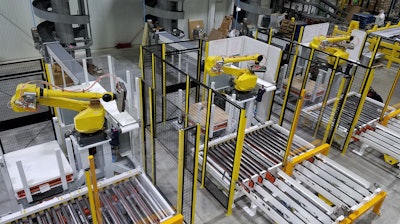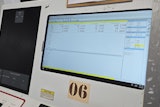
Behind many of the most well-known private-label and store brands of cheese and cheese products sold in North American supermarkets is one of the country's largest cheese maturation and cheese converting processors. Supplying more than 250 million pounds of cheese annually to grocery chains, wholesalers, restaurants and distributors, Wisconsin-based Masters Gallery Foods maintains one of the largest privately-held cheese inventories in the United States.
The company's extensive product line includes American favorites like mild and aged Cheddars; combination cheeses like Colby Jack and Monterey Jack with Peppers; Italian stretched-curd cheeses such as Mozzarella and Provolone, and hard-grating Parmesan, Romano and Asiago; specialty cheeses including Brie, Gouda and Swiss; and processed cheeses blended to deliver a consistent texture and flavor.
These cheeses come from producers, and arrive in bulk at Masters Gallery Foods' facilities where they are aged in six temperature-controlled warehouses, then converted, cut, packaged and shipped throughout North America for retail, foodservice and industrial use. Although each cheese ages, shreds and cuts differently, only premier cheeses leave the company's facilities.
"Our passion is for quality cheese," said Mark Wirtz, Engineering Manager at Masters Gallery Foods. "This starts with assuring quality, consistency and reliability of our cheese suppliers. Each and every vat of cheese that comes through our doors is personally tasted, smelled and tested by one of our 14 licensed cheese graders to ensure it has the compositional and sensory attributes to meet the highest standards. Our processes ensure that quality cheeses and custom blends will meet our customers’ needs. That means only the exact age, body, flavor, color and performance of cheese will be cleared for release to our customers."
Preserving Diversity
For retail markets, Masters Gallery Foods produces hundreds of cheese products in the form of slices, bars, shreds, chunks and sticks, packaged in pouches, loaves and tubs. For foodservice, five- and ten-pound packages of shreds, dices, cubes, slices and loaves are prepared. To service its industrial customers – for cut-and-wrap operators, food processors, cheese ingredient makers and finished food manufacturers – the company provides six-pound, forty-pound and 640-pound cheese blocks under its in-house Wisconsin Premium™ brand. Multiple storage facilities allow Masters Gallery Foods to house extensive inventories of cheese, helping its customers manage risk, hedge the dairy market, maintain fixed pricing and procure just-in-time inventories.
Managing this volume and diversity of product requires highly specialized automation able to adapt flexibly to changes in product runs. "To support this market need for customized product, we have to push our automation as far as we can, and make it do things that it was not designed to do," continued Wirtz. "We are always redesigning our machinery. Our automated systems from the onset are very unique, and originally built so they can be modified with minimal difficulty."
This is particularly important with the company's end-of-line packaging systems, where maintaining consistent, high throughput is critical to keeping upstream processes moving. Each of the company's six maturation facilities employs sophisticated robotics for both case packing and palletizing.
Designed by Quest Industrial, these robotic systems are unique in their capability for precision gripping and placement at high speeds, as well as their flexibility to adapt in real time to changes in product mix.
"Quest understands our challenges," explained Wirtz. "The company has been building robotics systems for our end-of-line packaging for the past ten years, specifically, robotic case packers and robotic palletizers. These are highly customized systems built to our requirements, but with tremendous flexibility to accommodate our need for modification of the equipment in-house.
"Each of the case packers is unique for the process it is designed to handle, but fundamentally, we require the case packers to have extreme flexibility. We are using Quest's Quik Pick QP200 robotic case packers in our plants. Essentially, the robot picks up an item from an accumulation conveyor and places it into a case.
"An example of one of our applications – the robot needs to be capable of picking up super small cheese items that weigh less than one ounce, and then pick up a package that is bulky and weighs two pounds. This level of flexibility is what is needed for our case packing processes."
The Quik Pick system is a high-speed robotic case packer, with its main differentiating point being its flexibility. Through its touchscreen HMI and custom software, it can be configured for product in-feed rates from 20 to more than 400 pieces per minute product weights from 1/2-ounce to 20 lbs."
Simplifying Robotic Palletizing
Masters Gallery Foods has nine robotic palletizers in operation within its six maturation facilities. These are used for end-of-line finished palletizing of cases before stretch wrapping and movement into chilled storage. All of these palletizers were developed by Quest working directly with the engineering team at Masters Gallery Foods. Three of these Boxed-Bot® robotic palletizers were just recently installed at the company's new plant, a section of which has been designed based upon the Toyota Production System (TPS).
"We are going into the initial phases of kicking off our own operational excellence plan, which we call the Island of Excellence, modeled off of the TPS," adds Wirtz. "This new plant produces various products of sliced cheeses. We have installed three Quest Boxed-Bot robotic palletizers that have unique capabilities which support our Island of Excellence plan."
One of these features is an over/under capability for movement of pallets within the palletizing cell. A forklift sets a pallet on the infeed conveyor that moves it in towards the robot. The pallet is elevated about 18 inches, once the palletizing is done, then the completed pallet is ejected back over the top of the conveyor to the start of the infeed for pick up with a forklift. With palletizer speeds of over 30 cycles per minute, this permits the forklift operator to wait for palletization to be completed without having to make a return trip.
Another feature is the integration of a custom-designed foam gripper, utilizing a foam pad to compensate for top-of-case irregularities. "Without the foam gripper, it would limit the products that the palletizer actually can run," continued Wirtz. "Some of the cases would need to be hand stacked by manual labor. The need to have a robotic palletizer that can handle 50 different case types is quite unusual. Most can handle just a fraction of case variations, but these Boxed-Bot robotic palletizers we have in our plants can handle any case size."
Behind much of this functionality is Quest's QBox® robotic palletizing software. The software makes it easy to drag-and-drop to change box or packaging patterns. Integrating versatile and intuitive robotic case packing and palletizing has enabled more options for customized case and pallet configurations, faster changeovers for different packaging runs, and reduced downtime, with more consistent end-of-line throughput.
States Wirtz, "It is helping us move closer towards achieving our Island of Excellence goals."























